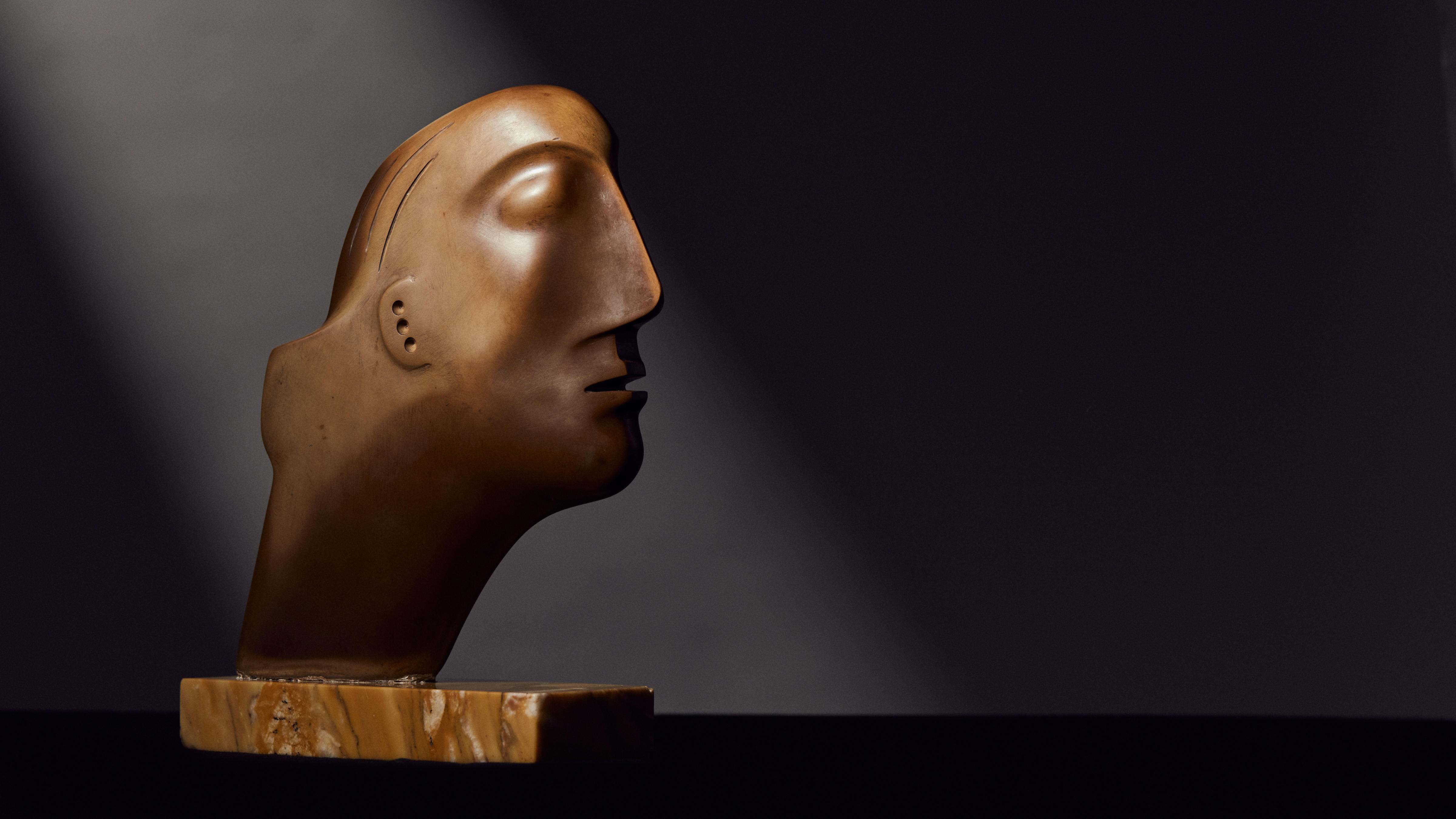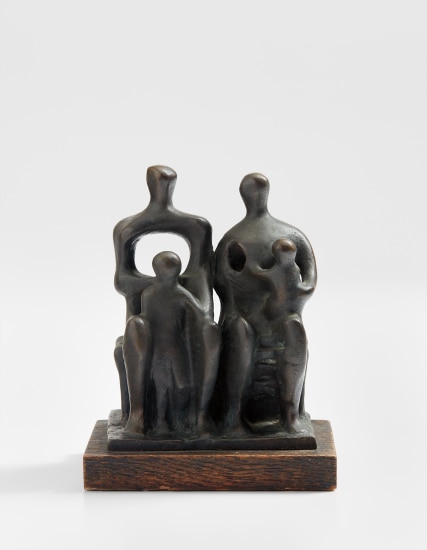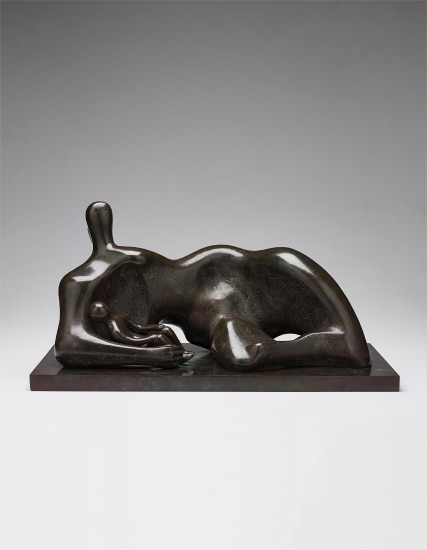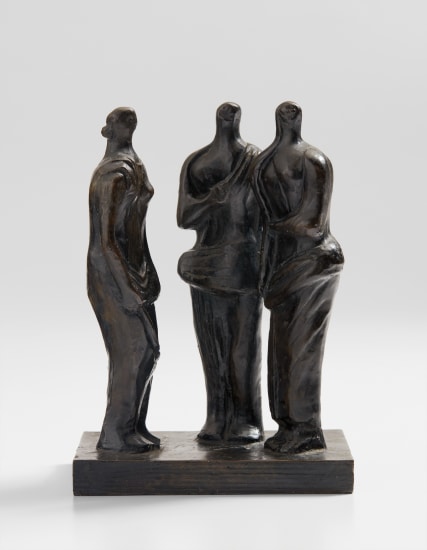Henry Moore O.M., C.H. (British, 1898-1986)Reclining Figure No. 6 bronze with a brown patina on a stone base 22 cm. (8 5/8 in.) long (excluding the base) Conceived in 1954 and cast in bronze in 1956, in an edition of 12 plus 1 artist's proofFootnotesProvenance With Marlborough Fine Art, London, circa late 1950s, where acquired by Private Collection, U.S.A. Private Collection, U.K. Literature Ionel Jianou, Henry Moore Arted, Paris, 1968, p.79, cat.no.346 Robert Melville, Henry Moore Sculpture and Drawings, 1921-1969, Thames and Hudson, London, 1970, n.p., cat.no.487 (ill.b&w, another cast) Alan Bowness (ed.), Henry Moore Volume 2: Complete Sculpture 1949-54, Lund Humphries, London, 1986, p.45, cat.no.337 (ill.b&w, another cast) John Hedgecoe Henry Moore A Monumental Vision, Collins & Brown, London, 1998, p.216, cat.no.308 (col.ill., another cast) Reclining Figure No.6 represents the culmination of a focused examination by Moore of one of his most fundamental themes, the reclining figure. This examination is displayed across a concise group of maquette-scaled figures, numbered 1 to 6 and executed between 1952 and 1954. Moore utilises a variety of treatments across this small group, and together they display the vast breadth of Moore's concern with this motif. Some of the group nod towards classicism, rendered naturalistically and clothed in drapery with precisely described details such as hands, faces and hair. Others recall primitive and ancient carving, with symbolist features that draw upon the Mayan chacmools which had many years prior first ignited Moore's fascination with the reclining form. Some, including Reclining Figure No.6, are abstracted to a greater degree. Their figural forms appear to have been mined from within the sculptor's material itself and are most attuned to Moore's concern with landscape. The legs and arms are denoted by piercings and negative space, hips, and shoulders by refined planes of mass. Their bodies are composed of great peaks and valleys, they are diminutive in scale, but substantial in presence. It was this specific form, Reclining Figure No.6, which Moore deemed so successful that he scaled it up to an eight-and-a-half foot elmwood carving, Reclining Figure of 1959-64 (now in the collection of The Henry Moore Foundation). Over his career Moore carved just six great reclining figure elmwood carvings, the first in 1935, the last in 1978. They are generally considered some of his finest work, in which the artist's control of the wood's broad grain to articulate the undulations of flesh is perhaps the strongest demonstration of his credence of truth to material. Five of the six Elmwood carvings, including the one relating to the present work, are in international museum collections. Interestingly, the maquette for Reclining Figure No.6 (now in the collection of The Henry Moore Foundation) was formed from a skeleton of plaster, over which the artist applied a surface layer of wax. This was an experimental use of materials for Moore, but highly successful. The sturdiness of the plaster allowed for a dynamic architectural form, awarding the figure a powerful rhythmic presence, yet the pliable wax layer affords a finer degree of refinement resulting in a highly nuanced surface. It should be noted that Moore's preoccupation with the present form began with the maquette in 1952-3 and peaked with completion of the elmwood carving in 1964. This period straddles one of Moore's greatest commissions, the monumental 16-foot UNESCO figure of 1956-8 carved in travertine marble. The two compositions share several features such as the enlarged and planed shins, which counterbalance the visual weight of the upright torso, and the alert, raised head which sits above a series of ovoid holes formed by poised limbs. Other casts from this edition are in the collections of the Montréal Museum of Fine Arts, The Henry Moore Foundation and the Milwaukee Art Museum.
Henry Moore O.M., C.H. (British, 1898-1986)Reclining Figure No. 6 bronze with a brown patina on a stone base 22 cm. (8 5/8 in.) long (excluding the base) Conceived in 1954 and cast in bronze in 1956, in an edition of 12 plus 1 artist's proofFootnotesProvenance With Marlborough Fine Art, London, circa late 1950s, where acquired by Private Collection, U.S.A. Private Collection, U.K. Literature Ionel Jianou, Henry Moore Arted, Paris, 1968, p.79, cat.no.346 Robert Melville, Henry Moore Sculpture and Drawings, 1921-1969, Thames and Hudson, London, 1970, n.p., cat.no.487 (ill.b&w, another cast) Alan Bowness (ed.), Henry Moore Volume 2: Complete Sculpture 1949-54, Lund Humphries, London, 1986, p.45, cat.no.337 (ill.b&w, another cast) John Hedgecoe Henry Moore A Monumental Vision, Collins & Brown, London, 1998, p.216, cat.no.308 (col.ill., another cast) Reclining Figure No.6 represents the culmination of a focused examination by Moore of one of his most fundamental themes, the reclining figure. This examination is displayed across a concise group of maquette-scaled figures, numbered 1 to 6 and executed between 1952 and 1954. Moore utilises a variety of treatments across this small group, and together they display the vast breadth of Moore's concern with this motif. Some of the group nod towards classicism, rendered naturalistically and clothed in drapery with precisely described details such as hands, faces and hair. Others recall primitive and ancient carving, with symbolist features that draw upon the Mayan chacmools which had many years prior first ignited Moore's fascination with the reclining form. Some, including Reclining Figure No.6, are abstracted to a greater degree. Their figural forms appear to have been mined from within the sculptor's material itself and are most attuned to Moore's concern with landscape. The legs and arms are denoted by piercings and negative space, hips, and shoulders by refined planes of mass. Their bodies are composed of great peaks and valleys, they are diminutive in scale, but substantial in presence. It was this specific form, Reclining Figure No.6, which Moore deemed so successful that he scaled it up to an eight-and-a-half foot elmwood carving, Reclining Figure of 1959-64 (now in the collection of The Henry Moore Foundation). Over his career Moore carved just six great reclining figure elmwood carvings, the first in 1935, the last in 1978. They are generally considered some of his finest work, in which the artist's control of the wood's broad grain to articulate the undulations of flesh is perhaps the strongest demonstration of his credence of truth to material. Five of the six Elmwood carvings, including the one relating to the present work, are in international museum collections. Interestingly, the maquette for Reclining Figure No.6 (now in the collection of The Henry Moore Foundation) was formed from a skeleton of plaster, over which the artist applied a surface layer of wax. This was an experimental use of materials for Moore, but highly successful. The sturdiness of the plaster allowed for a dynamic architectural form, awarding the figure a powerful rhythmic presence, yet the pliable wax layer affords a finer degree of refinement resulting in a highly nuanced surface. It should be noted that Moore's preoccupation with the present form began with the maquette in 1952-3 and peaked with completion of the elmwood carving in 1964. This period straddles one of Moore's greatest commissions, the monumental 16-foot UNESCO figure of 1956-8 carved in travertine marble. The two compositions share several features such as the enlarged and planed shins, which counterbalance the visual weight of the upright torso, and the alert, raised head which sits above a series of ovoid holes formed by poised limbs. Other casts from this edition are in the collections of the Montréal Museum of Fine Arts, The Henry Moore Foundation and the Milwaukee Art Museum.
.jpg)


.jpg)


.jpg)
.jpg)







Try LotSearch and its premium features for 7 days - without any costs!
Be notified automatically about new items in upcoming auctions.
Create an alert